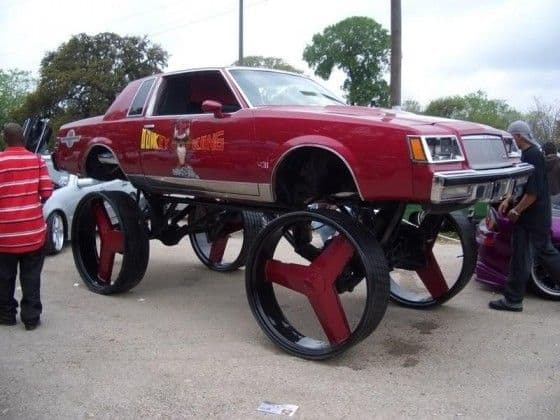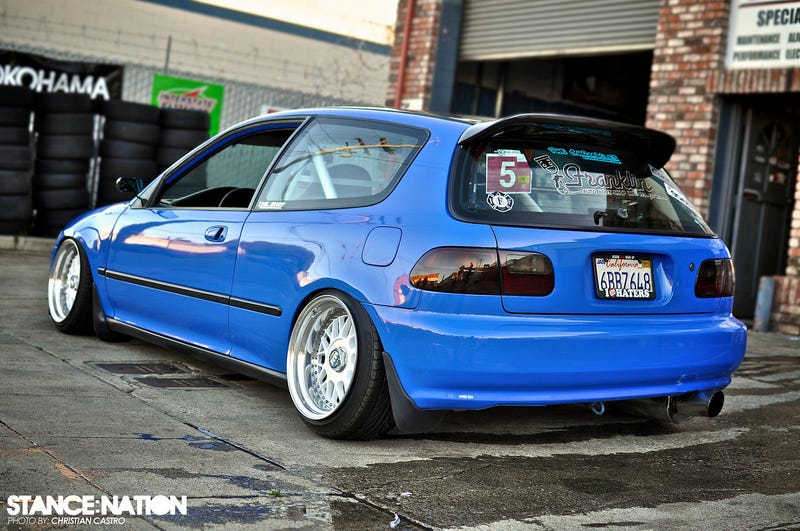
Posted on 09/09/2016 7:30:44 AM PDT by MeneMeneTekelUpharsin
To inform the public, it is known among auto industry experts that oversize rims, 20", 22" and 24", etc. eventually destroy transmissions, clutches, seals and axel bearings, etc. due to the torque factor required to turn those. Don't know if the MSM or other media have reported this, but it is a fact. Those who read here and seek the truth have another tidbit to share with family and friends.

As long as the circumference and total weight of the wheel remain the same(or close to the same) there is no effect. Simple physics. Width changes can and do impact suspension performance.
I’m a civil engineer...so not quite as smart as your husband. But I do work on cars alot. I never like to modify anything from OEM, because there are so many variables. If these rims are heavier or cause an overall taller tire, I can see them causing problems. With newer cars especially, there isn’t a huge factor of safety with alot of parts. Also it hasn’t been mentioned yet, but often lift kits are used to make room for taller tires on these rims...screwing with shaft angles and cv joints.
Another FYI, Memphis has a number of rim shops that actually rent or rent-to-own rims. If you don’t mind 21% interest, with a little down, in five years your metallic candy green ‘86 Delta 88 can have free and clear 24’s.
The larger wheel, complete with a narrow tire will concentrate more mass at larger radius...consequently has a higher Moment of Inertia....so more energy is required to spin the wheels.
I agree with your posit.
I find your posit to possess merit.
As an aside: I use those rims as an indicator of who to avoid on the road.
It is indicator of an alien culture that does not share my values, in this case the values of driving like a human being who is aware that they can kill somebody with their car.
And if it is just cosmetic and you don’t apply that torque you will be fine.
He used to have some pithy comments on what happened mechanically with different offsets, diameter changes, added unsprung weight and "wrong" cross-sectional tire profiles. In the 1960's, so many of us kids wanted the "drag race" look on our street cars, and he would just shake his head. His general thought on the matter was that if you wanted better wheels and tires on your car than what the factory put on it, get what they were putting on the closest equivalent police or highway patrol "interceptor."
Mr. niteowl77
Hellz yeah!
An old saying that I have heard “you can’t hotrod just a little bit.”
A change in one area usually equals a change elsewhere.
It depends more on the outside diameter of the tire. Personally, I’m not a fan of the big rim/low sidewall combo.
It’s not the rim size that matters - it’s the overall TIRE diameter that matters.
Increasing the rim size, but decreasing the tire profile so the total outside diameter of the tire is the same does nothing to the gearing ratio.
Obviously, you can go to a rim with an OD bigger than the original tire - and you’re screwed! But putting a bigger tire on a stock rim does the same thing.
It’s the outside diameter of the tire that matters.
How about the little Honda’s and Toyota cars that have the wheel sticking out of the wheel well. A lot of times the wheels are on a slanted angle. I think the tires are wide more then anything else.

.
>> “Sounds like an urban legend.” <<
.
Sounds like basic physics (Mechanics).
.
.
>> “This country is steeped in lies and corruption.” <<
No kidding!
.
Yeah baby!
I know that 35” tires with a 3” lift really make a Jeeps ball joints happy..
Miss the days of Cragar S/S or aluminum slots and chromed go-faster valve covers that made one happy...
I have had my own tire changing equipment for decades. These days because of legal issues there are many shops that will only put the exact size tire recommended by the manufacturer on a vehicle. I have been running tires a couple sizes larger or smaller if I pleased on vehicles my entire adult life.
It is very common for people with 4 wheel drive vehicles to use oversized tires without very many negative repercussions. Do you need to use a little common sense? Obviously! But what is going to put a larger strain on your running gear, towing an 8000 lb. trailer up a hill or using tires that are a couple inches larger in diameter? Personally the biggest financial hazard for me is remembering to make the mental adjustment to the speedometer which then reads a few miles per hour slower than you are traveling at freeway speeds. Of course you can get a different gear for your speedometer if that becomes a real problem.
In the same vein I had a practically new set of studded snow tires for a Ford Aerostar that I sold. They were slightly smaller in diameter than the tires that came on the Chevy Astrovan that I replaced it with. And I had to buy a set of hub adapters so I could use the Ford wheels on the Chevy. But again, it did not create any problems and saved several hundred dollars compared to buying a new set of studded snow tires.
So this is just to clarify. I realize that what you are talking about are these guys who put gigantic rims on their vehicles. Personally, I think this is stupid and likely to cause issues. This is especially true on a front wheel drive car or van whose transmissions’ are typically lighter duty than a truck or rear wheel drive van. Plus modern cars typically have less tolerance for additional strain than older cars and trucks. They have taken a lot of the beef out of them to make them lighter.
Disclaimer: Opinions posted on Free Republic are those of the individual posters and do not necessarily represent the opinion of Free Republic or its management. All materials posted herein are protected by copyright law and the exemption for fair use of copyrighted works.